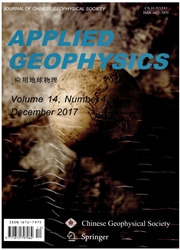

 中文摘要:
中文摘要:
在地震小浪振幅光谱精确地被估计的假设上,有不同阶段系列的一组小浪,是估计了小浪考虑了,被用来实现线性最少平方的倒置。在倒置期间,除了小浪阶段,影响倒置结果的所有另外的因素没被考虑。稀少的反射率的倒置结果当模特儿(或短而粗的阻抗模型) 显示出那:(1 ) 尽管用倒置结果的合成数据与原来的地震数据匹配很好,转换反射率和声学的阻抗与真正的模型的不同。(2 ) 倒置结果可靠性依赖于估计的小浪 Z 变换根分发。当估计的小浪 Z 变换根仅仅在联合起来的圆附近不同于真实小浪的时,转换反射率和阻抗与真正的模型通常一致;(3 ) 尽管合成数据与原来的数据和 Cauchy 标准匹配很好(或修改 Cauchy 标准) 与一个常数,抑制参数被优化了,转换结果极大地是静止的与真正的模型不同。最后,我们作为评估标准与适应抑制参数用 L1 标准,峭度,变化,有适应抑制参数的 Cauchy 标准或 / 并且修改 Cauchy 标准建议减少不精密的小浪阶段评价的坏影响并且在理论获得好结果。
 英文摘要:
英文摘要:
On the assumption that the seismic wavelet amplitude spectrum is estimated accurately, a group of wavelets with different phase spectra, regarded as estimated wavelets, are used to implement linear least-squares inversion. During inversion, except for the wavelet phase, all other factors affecting inversion results are not taken into account. The inversion results of a sparse reflectivity model (or blocky impedance model) show that: (1) although the synthetic data using inversion results matches well with the original seismic data, the inverted reflectivity and acoustic impedance are different from that of the real model. (2) the inversion result reliability is dependent on the estimated wavelet Z transform root distribution. When the estimated wavelet Z transform roots only differ from that of the real wavelet near the unit circle, the inverted reflectivity and impedance are usually consistent with the real model; (3) although the synthetic data matches well with the original data and the Cauchy norm (or modified Cauchy norm) with a constant damping parameter has been optimized, the inverted results are still greatly different from the real model. Finally, we suggest using the L1 norm, Kurtosis, variation, Cauchy norm with adaptive damping parameter or/and modified Cauchy norm with adaptive damping parameter as evaluation criteria to reduce the bad influence of inaccurate wavelet phase estimation and obtain good results in theory.
 同期刊论文项目
同期刊论文项目
 同项目期刊论文
同项目期刊论文
 期刊信息
期刊信息
